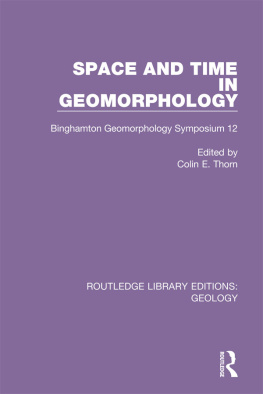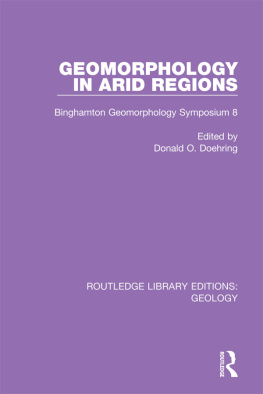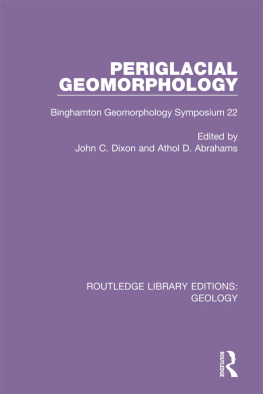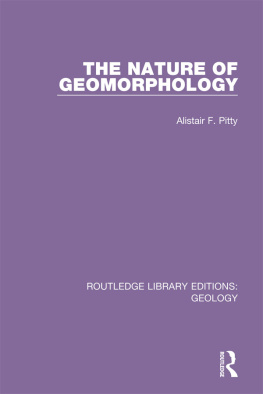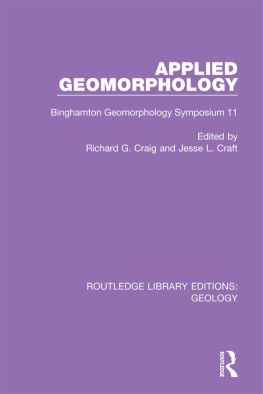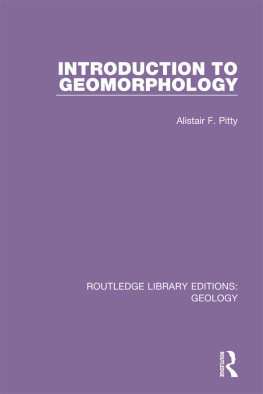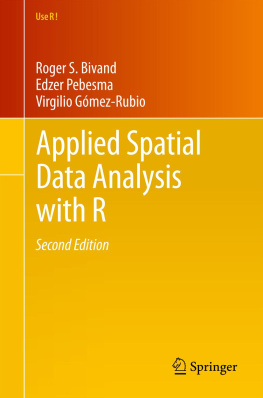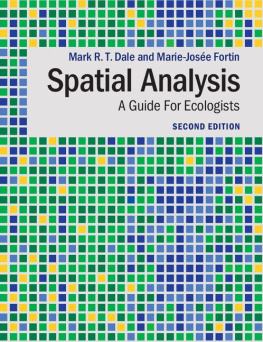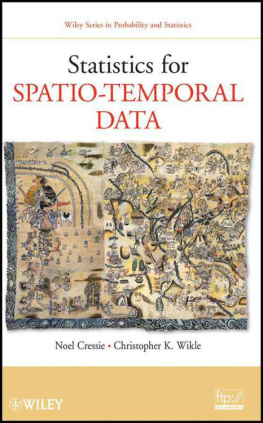Contents
Guide
Print Page Numbers

ROUTLEDGE LIBRARY EDITIONS:
GEOLOGY
Volume 27
SPACE AND TIME IN
GEOMORPHOLOGY
SPACE AND TIME IN
GEOMORPHOLOGY
Binghamton Geomorphology Symposium 12
Edited by
COLIN E. THORN

First published in 1982 by George Allen & Unwin Ltd
This edition first published in 2020
by Routledge
2 Park Square, Milton Park, Abingdon, Oxon OX14 4RN
and by Routledge
52 Vanderbilt Avenue, New York, NY 10017
Routledge is an imprint of the Taylor & Francis Group, an informa business
1982 Colin E. Thorn
All rights reserved. No part of this book may be reprinted or reproduced or utilised in any form or by any electronic, mechanical, or other means, now known or hereafter invented, including photocopying and recording, or in any information storage or retrieval system, without permission in writing from the publishers.
Trademark notice: Product or corporate names may be trademarks or registered trademarks, and are used only for identification and explanation without intent to infringe.
British Library Cataloguing in Publication Data
A catalogue record for this book is available from the British Library
ISBN: 978-0-367-18559-6 (Set)
ISBN: 978-0-429-19681-2 (Set) (ebk)
ISBN: 978-0-367-27667-6 (Volume 27) (hbk)
ISBN: 978-0-429-29797-7 (Volume 27) (ebk)
Publishers Note
The publisher has gone to great lengths to ensure the quality of this reprint but points out that some imperfections in the original copies may be apparent.
Disclaimer
The publisher has made every effort to trace copyright holders and would welcome correspondence from those they have been unable to trace.
Space and Time in
Geomorphology
Edited by Colin E. Thorn
Department of Geography, University of Illinois at Urbana-Champaign
London
GEORGE ALLEN & UNWIN
Boston Sydney
Copyright 1982 by Colin E. Thorn
First published in 1982
This book is copyright under the Berne Convention. All rights are reserved. Apart from any fair dealing for the purpose of private study, research, criticism or review, as permitted under the Copyright Act, 1956, no part of this publication may be reproduced, stored in a retrieval system, or transmitted, in any form or by any means, electronic, electrical, chemical, mechanical, optical, photocopying, recording or otherwise, without the prior permission of the copyright owner. Enquiries should be sent to the publishers at the undermentioned address:
GEORGE ALLEN & UNWIN LTD.
40 Museum Street, London WC1A 1LU
LIBRARY OF CONGRESS CATALOGING IN PUBLICATION DATA SPACE AND TIME IN GEOMORPHOLOGY
Bibliography: P.
Includes Index.
1. GeomorphologyCongresses.
I. Thorn, Colin E.
GB400.2.S67 551.4 81.21740
ISBN 0-04-551056-3 AACR2
BRITISH LIBRARY CATALOGUING IN PUBLICATION DATA
Space and time in geomorphology.(The Binghamton symposia in geomorphology; no. 12)
1. Geomorphology-Congresses
I. Thorn, Colin E. II. Series
551.4 GB400.2
ISBN 0-04-551056-3
Produced by
Publishers Creative Services Inc., New York and printed in Great Britain by Mackays of Chatham Ltd
Contents
Uniformitarianism and the ergodic hypothesis are fundamental concepts in contemporary geomorphology. In the case of uniformitarianism there has been a protracted debate over the true usefulness of the term (e.g. Gould 1965). In truth, the worst that can be said about it is that it is cacophonous and anachronistic. However, the ergodic hypothesis has rarely been put to the test (Savigear 1952 is one of a few classic exceptions), although in a generalized form it is inextricably woven into the fabric of contemporary geomorphology.
As geomorphic theory has developed, both uniformitarianism and the ergodic hypothesis have been recast. Magnitude and frequency (Wolman & Miller 1960) updated simplistic uniformitarianism, only to be modified itself by the notions of healing time (Wolman & Gerson 1978), episodic erosion (Schumm 1977) and the entire range of threshold-related concepts (Coates & Vitek 1980). Church and Mark (1980) have seriously questioned ergodic principles (space time substitution) in their comparison of static and dynamic allometry. Indeed, Church (1980) has gone right to the heart of the matter by suggesting that process geomorphology provides little or no insight into landscape evolution. Such a perspective appears readily defensible and places even greater onus on stratigraphic interpretation for studies of landscape evolution. Unfortunately, the weak linkage between the alluvial record and interfluvial geomorphology (Costa 1975, Caine 1974), plus an insightful reappraisal of the stratigraphic record itself (Ager 1973) suggest an equally pressing need for careful reconsideration of traditional concepts on these fronts as well.
Clearly, geomorphology stands at something of a Rubicon. Faced with a dearth of data, it is essential to press forward on another front, namely, that of establishing a more cogent and comprehensive paradigm. There is certainly nothing new in this notion, as it has been stated eloquently by Davis (1899) and Chorley (1962). A meaningful grasp of landscape evolution would seem to depend upon: (a) understanding the present spatial distribution of processes and process rates, especially the linkage between erosional and depositional components; (b) comparison of spatial versus temporal change; and (c) careful appraisal of the character and composition of the stratigraphic record. The size of the task is herculean, but one obvious starting point is a theoretical examination of the characterisitics of available data sets for the specific purpose of shaping future field measurement studies more purposefully.
This symposium was conceived with many of the above points in mind. It was inspired by the success and significance of the ninth Binghamton symposium on thresholds in geomorphology (Coates & Vitek 1980) and was consciously designed to complement the initial focus on across-threshold variability with one upon between-threshold variability. Each participant was invited to use a data set to address between threshold variability in either a spatial or temporal context or, if possible, both.
The paper by Derek C. Ford and John J. Drake makes a singularly appropriate introduction because in it they suggest that karst erosion has no intrinsic thresholds and therefore the entire span of Holocene time constitutes a meta-stable karst erosion phase. Integration of a variety of measurement techniques permits variations in limestone erosion and speleothem deposition to be examined over a range of timescales. However, temporal variability can be successfully evaluated only in association with a sound grasp of spatial variability.
Equilibrium concepts are central to geomorphology, and John B. Thornes sets out to examine both the behavior and stability of equilibria. He is able to demonstrate that autocorrelative properties permit recognition of basic process structures in temporal series, even when a large portion of the data sequence is missing. Estimation of spatial and temporal variability using the normal generated distribution (ngd) is developed and demonstrated by H. Charles Romesburg and Jerome V. DeGraff. The ngd is particularly flexible and its estimation is simpler than that of the beta-binomial distribution. The ergodic hypothesis is tested mathematically by Richard G. Craig, using data from the Appalachian Mountains of Pennsylvania. In addition to tending to confirm the ergodic principle, the model suggests that stable landforms cannot occur, but that there is an oscillating effect about a preferred value.

